Valley of the Kings: A Complete Guide to Egypt’s Royal Afterlife Gateway

The Valley of the Kings remains one of the most extraordinary archaeological landscapes on Earth—a silent desert valley that once guarded the eternal resting places of Egypt’s most powerful rulers. Located on Luxor’s West Bank, this timeless necropolis has fascinated explorers, historians, and travelers for centuries. With its maze of rock-cut tombs, vibrant wall scenes, and deep spiritual symbolism, the valley offers a rare chance to step directly inside the Valley of the Kings and witness the beliefs and craftsmanship of the ancient world.
This comprehensive guide blends history, mythology, architecture, and practical travel insight to help modern visitors experience the valley at its best. Whether you’re searching for the best tomb in the Valley of the Kings, curious about ancient rituals, or simply planning a memorable day in Luxor, the valley promises an unforgettable journey into Egypt’s royal past.
History of the Valley of the Kings
The story of the valley begins during Egypt’s New Kingdom (1550–1069 BCE), a period marked by strong pharaohs, far-reaching power, and innovative ideas about death and the afterlife. Unlike their pyramid-building ancestors, New Kingdom rulers sought a more protected burial ground—one that would keep their treasures safe from the early tomb robbers who plundered the pyramids.
They chose a secluded wadi west of Thebes (modern Luxor). The site offered two advantages: natural protection from the surrounding cliffs and a symbolic link to the setting sun, which the ancient Egyptians associated with death and rebirth. Towering above the valley is the mountain peak of Al-Qurn, shaped like a natural pyramid. Its appearance was powerful enough to influence the valley’s selection as a royal burial ground.
Over more than five centuries, craftsmen carved more than 60 tombs into the limestone, shaping long corridors, ritual halls, and underground chambers decorated with sacred texts. Although many tombs were robbed thousands of years ago, the artistry and architecture left behind make the valley an irreplaceable source of historical knowledge.
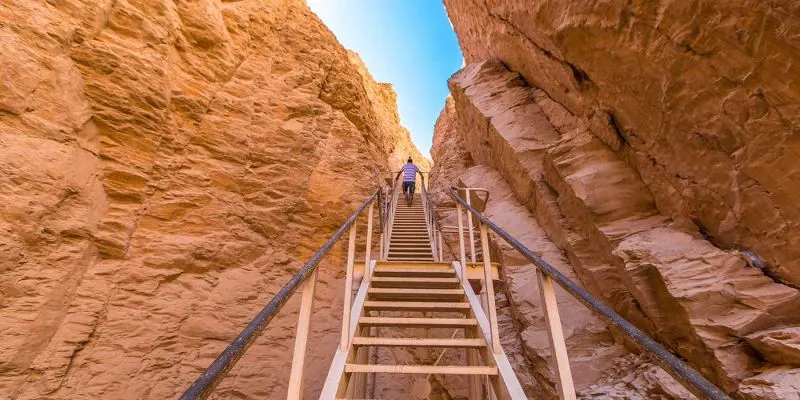
Why the Pharaohs Chose This Valley
The valley’s location aligns perfectly with Egyptian religious beliefs. The west bank of the Nile symbolized the world of the dead, where the sun god Ra “died” each evening before being reborn at dawn. By placing their tombs in this landscape, kings hoped to follow the same cycle—journeying through the underworld and rising again in the afterlife.
Spiritual significance wasn’t the only motivation. Isolation mattered. The valley’s rugged terrain made it difficult for robbers to approach unseen. Workers from the nearby village of Deir el-Medina lived in controlled conditions to preserve the secrecy of the tombs’ locations. This combination of practicality and symbolism shaped the history of the Valley of the Kings into one of the most remarkable burial traditions in the ancient world.
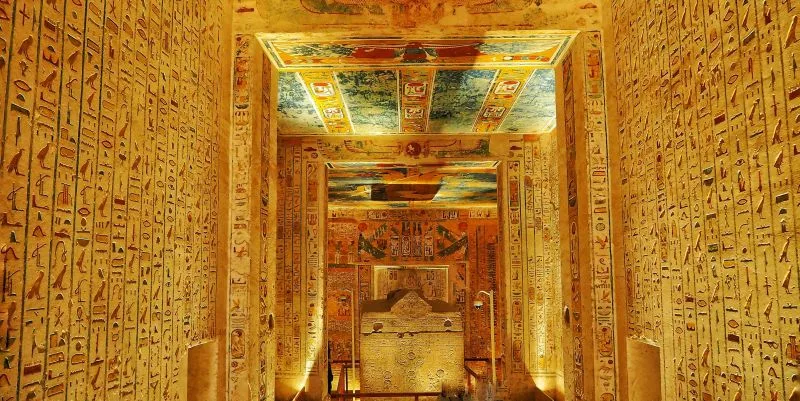
Where is the Valley of the Kings located?
The Valley of the Kings is located on the west bank of the Nile River near Luxor. It is the most famous site for having unique collections of tombs and breathtaking ancient ruins. That location makes it one of the hottest spots for exploring ancient Egyptian history. The richness of the findings here in the Valley of the Kings has kept archeologists busy for nearly two centuries. If all of the tombs here were open to visitors it would be nearly impossible actually to make it to all of them. Still, thankfully, the possibility of such a huge task is eliminated for you.
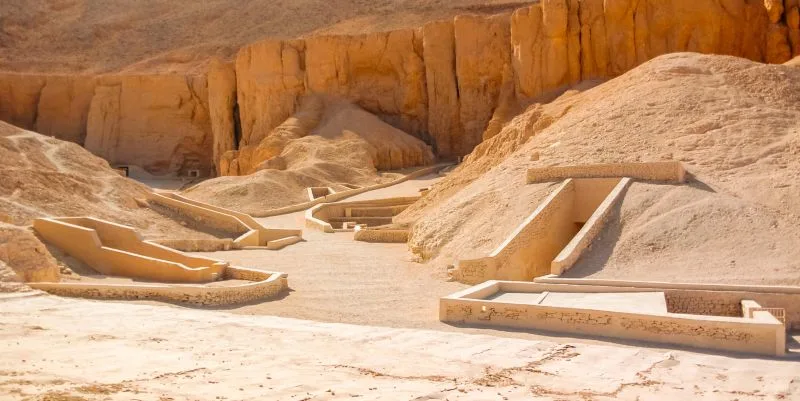
Customize Your Dream Vacation!
Get in touch with our local experts for an unforgettable journey.
Plan Your Trip
Inside the Valley of the Kings: Architecture and Meaning
Stepping inside the Valley of the Kings feels like entering the pages of a living history book. Beneath the sun-soaked desert lies one of the ancient world’s most sophisticated architectural achievements: a network of tombs designed as spiritual roadmaps for the journey into eternity.
Tomb Structure and Layout
Although each tomb is unique, most share the same basic structure:
- A descending entrance corridor
- A series of halls and passageways
- A deep burial chamber often decorated with celestial ceilings
- Side rooms for funerary goods
Early tombs used a “bent-axis” design with sudden turns, which later evolved into long, straight corridors that symbolized a direct path toward the afterlife. Many tombs include a mysterious shaft known as the “well,” which may have served both symbolic and practical purposes—possibly drainage, protection, or a magical barrier against evil.
Wall Art and Funerary Texts
Every inch of the tomb walls carries meaning. Elaborate scenes recounting the sun god’s journey, the trials of the underworld, or the king’s transformation appear in dazzling colors. Major funerary books include:
The Amduat – detailing 12 hours of the night
- The Book of Gates – portraying the sun’s passage through guarded portals
- The Book of Caverns – emphasizing rebirth
- The Book of the Dead – offering spells for protection
These texts weren’t simple decoration. Ancient Egyptians believed that the images themselves held magical power—capable of ensuring the king’s successful transition to eternity.
Best Tombs in the Valley of the Kings
Travelers often wonder about the best tomb in the Valley of the Kings, and while opinions differ, several tombs stand out for their beauty, scale, and historical importance.
1. Tomb of Seti I (KV17) – A Masterpiece
Widely considered the most exquisitely decorated tomb in the valley, KV17 is a vast corridor of detailed reliefs and celestial artwork. Its colors remain remarkably vivid. A special ticket is required, but enthusiasts consider it the valley’s crown jewel.
2. Tomb of Tutankhamun (KV62)
Though small compared to others, this tomb’s fame is unmatched. Discovered nearly intact in 1922, it yielded over 5,000 treasures. Today, visitors can enter the burial chamber and see King Tut’s actual mummy—an unforgettable experience.
3. Tomb of Ramses VI (KV9)
With its brilliant astronomical ceiling and extensive Book of Gates scenes, KV9 offers one of the most visually striking interiors in the valley.
4. Tomb of Ramses IV (KV2)
Brightly painted, accessible, and spacious, this tomb is a favorite for its brilliant ceiling scenes and well-preserved corridors.
5. Tomb of Ramses II’s Sons (KV5)
One of the largest tombs ever discovered, KV5 contains more than 120 chambers. It was designed to house the sons of Ramses II and remains a massive, still-developing archaeological site.
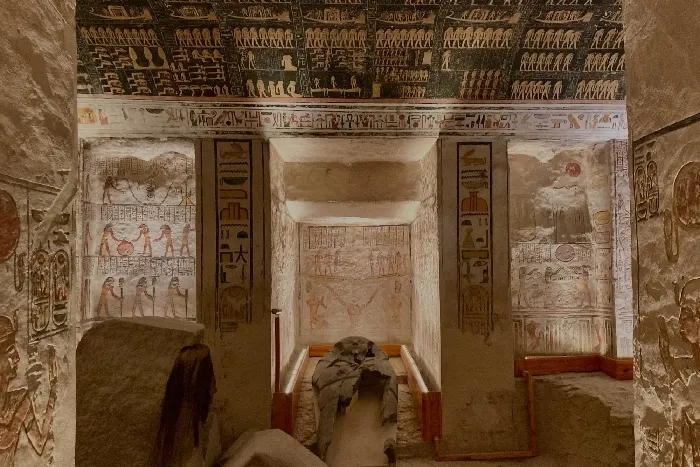
Visitors to the Valley of the Kings can enter several tombs, although access rotates to protect the ancient sites. Standard tickets typically include entry to three open tombs, such as KV2 (Ramses IV), KV9 (Ramses V/VI), or KV11 (Ramses III). Special tickets are required for KV17 (Seti I) and KV62 (Tutankhamun). Some tombs may be closed seasonally or for preservation. Planning ahead ensures you experience the best tombs in the Valley of the Kings.
Facts About the Valley of the Kings
Beyond its dramatic setting and intricate tombs, several fascinating details shape the valley’s unique identity. Here are some of the most interesting facts about the Valley of the Kings:
- Over 60 tombs have been discovered so far, and excavations continue.
- Many tombs stretch hundreds of feet underground, including Queen Hatshepsut’s at nearly 700 feet long.
- Al-Qurn’s natural pyramid-like shape played a major role in choosing the site.
- Tutankhamun’s tomb is the only major royal tomb found mostly intact.
- Workers of the Royal Necropolis lived in Deir el-Medina, one of Egypt’s best-preserved ancient villages.
- Tomb art serves as spiritual maps guiding the king through the afterlife.
- Unfinished tombs reveal ancient construction techniques and sudden events like a ruler’s unexpected death.
Modern Discoveries and Conservation Efforts
Even after a century of major exploration, new discoveries continue to redefine our understanding of the valley. Excavations in 2006 uncovered KV63, a mummification storage chamber filled with embalming materials and coffins. More recently, ongoing dig sites in the area suggest that more tombs may still lie hidden beneath the sand.
With more than a million visitors annually, conservation has become a priority. Humidity, dust, and heat threaten the delicate artwork, so authorities restrict access to certain tombs and use advanced ventilation systems to protect their fragile surfaces. These efforts ensure that the valley’s treasures remain preserved for future generations.
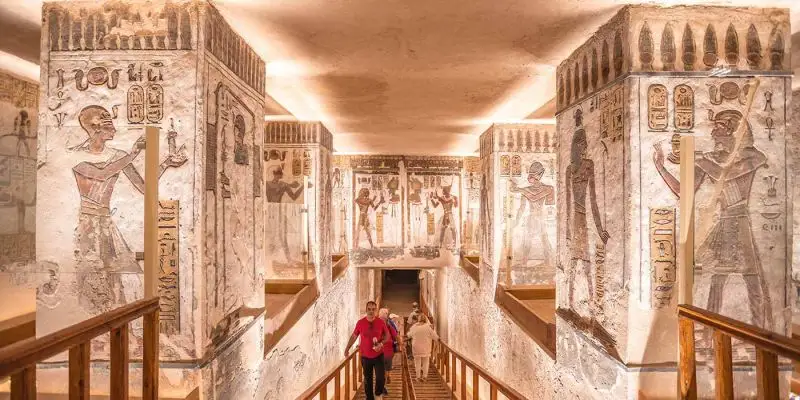
Guide to the Valley of the Kings: Visitor Essentials
Here’s a clear, easy-to-follow guide to the Valley of the Kings to help you plan your visit:
Location
Luxor’s West Bank, easily reached by boat, taxi, or a full-day tour.
Tickets
A general ticket includes entry to three open tombs (varies daily).
Additional tickets are required for:
- Seti I (KV17)
- Tutankhamun (KV62)
- Ramses V/VI (KV9), depending on season
Opening Hours
Usually 6:00 AM to late afternoon, with earlier visits recommended for cooler weather and fewer crowds.
What to Bring
- Water and sun protection
- Comfortable shoes
- Camera (depending on photography rules)
Tips for a Great Visit
- Start early—temperatures rise quickly.
- Combine your visit with Hatshepsut Temple or the Colossi of Memnon.
- If you love ancient art, Seti I and Ramses VI are must-sees.
- Allow 2–3 hours for a relaxed visit.
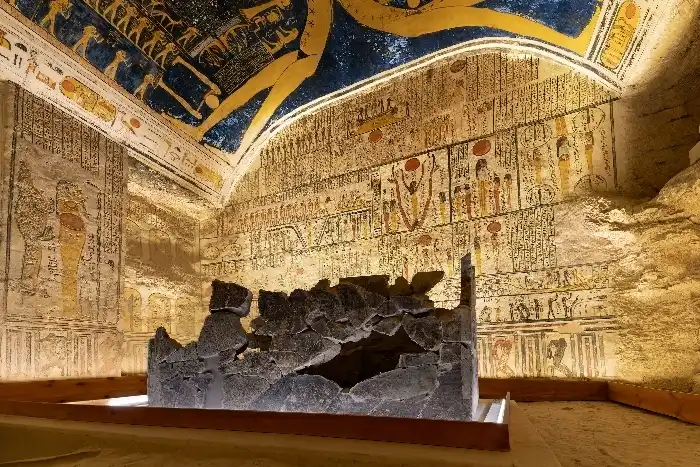
The Lasting Legacy of the Valley of the Kings
Today, the Valley of the Kings stands not only as a burial site but as a symbol of ancient Egyptian brilliance, devotion, and ambition. Its tombs reflect a civilization obsessed with preparing for eternity, leaving behind stories carved in stone that still captivate the world. From the breathtaking artwork of Seti I to the intimate discovery of Tutankhamun, the valley offers a direct encounter with ancient history unlike any other.
Whether you're exploring the best tomb in the Valley of the Kings, uncovering new facts about the Valley of the Kings, or simply admiring its dramatic desert scenery, the valley promises a journey deep into the heart of Egypt’s royal past—one that continues to reveal secrets thousands of years after the pharaohs’ reign.

Top Luxor Sites to Explore Alongside the Valley of the Kings
When visiting the Valley of the Kings, you can also explore these nearby Luxor attractions:
- Mortuary Temple of Hatshepsut – Elegant cliffside terraces honoring Egypt’s only female pharaoh.
- Colossi of Memnon – Iconic twin statues of Pharaoh Amenhotep III, perfect for photos.
- Temple of Medinet Habu – Ramses III’s mortuary temple with vivid battle and ritual reliefs.
- West Valley Tombs – Lesser-known royal tombs, including Amenhotep III’s, for a quieter visit.
- Deir el-Medina Village – Preserved workers’ village offering insight into daily life in the royal necropolis.
- Karnak Temple Complex – Massive temple with grand halls, obelisks, and sacred lakes.
- Luxor Temple – Centrally located, famous for statues and evening illuminations.
- Luxor Museum – Houses artifacts from tombs and temples in the Theban region.
- Hot Air Balloon Rides – Stunning sunrise views over the Nile, desert, and temples.
- Nile Cruises & Sound & Light Shows – Comfortable river tours and immersive historical performances.
The best time to visit the Valley of the Kings is during the cooler months, from October to April, when temperatures range between 20–30°C (68–86°F). Early mornings are ideal to avoid crowds and the midday heat. Visiting at sunrise offers a serene experience inside the Valley of the Kings, perfect for photography and exploring tombs at a relaxed pace.
The Valley of the Kings is an ancient Egyptian burial ground containing 63–65 royal tombs from the New Kingdom (1550–1069 BCE). Legendary pharaohs like Tutankhamun, Seti I, and Ramses II were buried here. Its importance lies in the remarkable architecture, artwork, and funerary texts, which provide insights into Egyptian beliefs about death, the afterlife, and royal traditions.
Yes, visitors can generally take photos with mobile phones, but some tombs may prohibit flash photography to protect delicate wall paintings. Always follow signage and guides’ instructions. Bringing a good camera enhances the experience of exploring the Valley of the Kings’ stunning interior.
Essentials include:
- Comfortable walking shoes for rocky paths
- Sunscreen, hat, and sunglasses for desert sun
- Plenty of water to stay hydrated
- A camera or smartphone (respecting tomb rules)
- Lightweight clothing to stay cool
Being prepared ensures you can fully enjoy your Valley of the Kings experience, especially when combined with a Nile cruise
The Valley of the Kings is famous for being the primary burial site for the pharaohs and powerful nobles of the Egyptian New Kingdom (approximately 1550 BC to 1070 BC). Its fame rests on the discovery of over 60 known royal tombs, particularly the nearly intact tomb of the boy-king Tutankhamun (KV62), which contained unimaginable treasures and captured global attention.


















